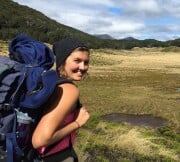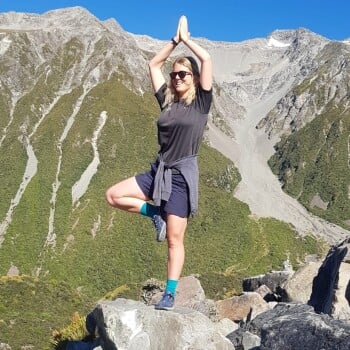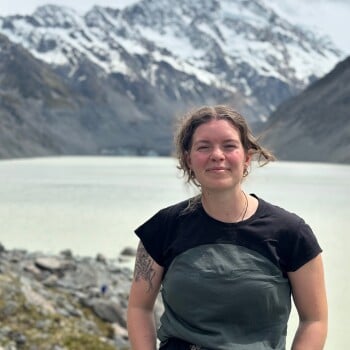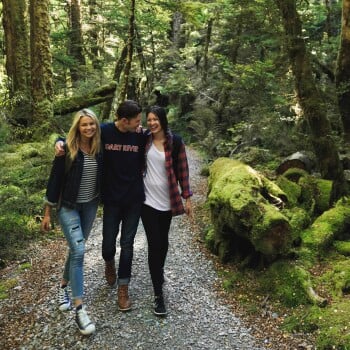- About Us
-
Trips
-
 Kiwi-Style Hiking
Kiwi-Style Hiking
-
 Great Walks
Great Walks
-
 Hiking Tours
Hiking Tours
-
Alpine Hikes
-
Custom Groups
- Huayhuash Trek
- Family Northern Explorer
- Family Southern Explorer
- Lake Waikaremoana Hike
- Women's Custom Tours
- Women's Southern Wilderness
- Coast, Canyons and Mountains
- Coastal Wanderer Custom Tour
- Don't Cross the Ladies
- Secret South Custom Tour
- Tekapo Hike
- West Coast Custom Tour
- World Heritage Custom Tour
-
- Blog
- Shortlist
- About Us
- Trips
- Blog
- Shortlist

Jul 19, 2024
Rewilding is a conservation approach that seeks to restore and rehabilitate ecosystems to a natural and self-sustaining state by reintroducing native plant and animal species, removing or managing invasive species, and allowing natural processes to shape the landscape. The goal of rewilding is to promote biodiversity, enhance ecosystem resilience, and re-establish ecological functions.
How does rewilding work?
Rewilding aims to create more resilient and self-sustaining ecosystems that can adapt to environmental changes. While the specific strategies may vary depending on the region and ecosystem, the overarching objective is to promote the restoration of natural processes and support the coexistence of diverse species in their native habitats.
Species Reintroduction: Reintroducing native species that have been extirpated or greatly reduced in numbers. This often includes apex predators and keystone species that play crucial roles in maintaining ecosystem balance. Or, in the case of Aotearoa, species that have been endangered by introduced predators.
Habitat Restoration: Rehabilitating and restoring natural habitats, allowing them to recover from human-induced disturbances such as deforestation or pollution.
Reducing Human Intervention: Allowing natural processes, such as predation and competition, to regulate populations and shape ecosystems. This involves minimising human intervention in managing wildlife populations.
Invasive Species Management: Controlling or removing invasive species that can disrupt native ecosystems and outcompete indigenous flora and fauna.
Connectivity: Creating or preserving wildlife corridors and habitat connectivity to facilitate the movement of species and promote genetic diversity.

Rewilding in Aotearoa
In New Zealand, rewilding efforts primarily focus on the removal of introduced predators rather than the reintroduction of apex predators. This approach is rooted in the unique ecological context of the islands. New Zealand lacks native land mammals, and its native fauna evolved in the absence of mammalian predators. When invasive species including rats, stoats, and possums were introduced, they wreaked havoc on the vulnerable native bird (and plant, gecko and invertebrate) species, leading to population declines and extinctions.
The removal of these invasive predators is prioritised to restore the natural balance and protect native biodiversity. Introducing apex predators, such as large carnivores, of course does not align with this goal, as unlike rewilding efforts in other parts of the world, there are no predators that have been extirpated from New Zealand’s natural environment (apart from the extinct Haast’s Eagle).
New Zealand's rewilding strategy emphasises the protection and restoration of endemic flora and fauna by eliminating the immediate threats posed by introduced predators. This tailored approach acknowledges the unique evolutionary history of New Zealand's ecosystems and aims to establish a more resilient and balanced environment for its native species.
Reducing human intervention in Aotearoa’s rewilding efforts will take time. That’s why Hiking New Zealand has always been involved in conservation, and recently we stepped-up to play a bigger role in rewilding our backyard.

Hiking New Zealand: Conservation at the Heart of Adventure
Hiking New Zealand is a company founded on a passion for exploring the country's diverse and breathtaking landscapes, and conservation has always been a part of our guiding ethos.
Southern Rewilding
Our commitment to conservation goes beyond responsible tourism, which is why we started Southern Rewilding, a subsidiary expressly designed to contribute to rewilding initiatives. Southern Rewilding aligns with the broader national mission of restoring New Zealand's ecological balance, acknowledging that protecting these pristine environments requires more than passive admiration—it demands active participation.
Since 2021, our dedicated conservation teams have been engaged in predator control operations in Arthur’s Pass National Park, directly safeguarding critically endangered species including the Kākāriki Karaka, Mohua, and Whio.
Simultaneously, our adept planting team has been diligently establishing new pockets of precious habitat in Canterbury and on Rēkohu, Chatham Island.
Rewilding is an essential approach to conservation the world over. Our impact is massive, and ultimately irreversible in some instances, without our intervention. Ultimately, we hope that rewilded pockets will grow into corridors and eventually large areas of Aotearoa will be nearly natural. Of course, we’ll mourn the bird songs silenced by extinction, but are optimistic that the dawn chorus will crescendo in years to come, as we do our part.






